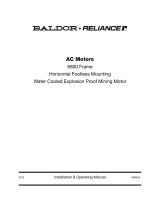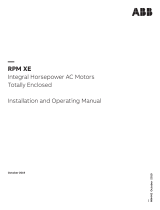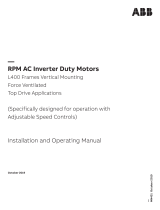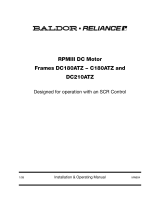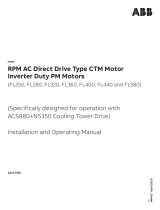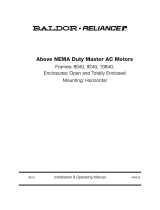
1-1MN405
Section 1
General Information
Overview
This manual contains general procedures that apply to Baldor Motor products. Be sure to read and
understand the Safety Notice statements in this manual. For your protection, do not install, operate or
attempt to perform maintenance procedures until you understand the Warning and Caution statements.
A Warning statement indicates a possible unsafe condition that can cause harm to personnel.
A Caution statement indicates a condition that can cause damage to equipment.
Baldor mining motors are sold to OEM (Original Equipment Manufacturers) companies who provide
motors and equipment containing these motors as their product offerings. Be sure to consult the OEM
documents for safety and regulatory information that is important to the application of these products.
Important:
This instruction manual is not intended to include a comprehensive listing of all details for all
procedures required for installation, operation and maintenance. This manual describes general
guidelines that apply to most of the motor products shipped by Baldor. If you have a question
about a procedure or are uncertain about any detail, Do Not Proceed. Please contact your OEM
for more information or clarication.
Before you install, operate or perform maintenance, become familiar with the following:
• IEC60034-1 Electrical and IEC60072-1 Mechanical specications.
Safety Notice:
This equipment contains high voltage! Electrical shock can cause serious or fatal injury. Only qualied
personnel should attempt installation, operation and maintenance of electrical equipment.
For US markets, be certain that you are completely familiar with MSHA (Mine Safety and Health Administration)
standards and regulations. For other markets, check for safety regulations and local codes applicable for your
region. In all locations, be completely familiar with safety standards for selection, installation and use of electric
motors and generators and other local codes and practices as applicable for your region. Unsafe installation
or use can cause conditions that lead to serious or fatal injury. Only qualied personnel should attempt the
installation, operation and maintenance of this equipment.
WARNING: Do not touch electrical connections before you first ensure that power has been disconnected. Electrical
shock can cause serious or fatal injury. Only qualified personnel should attempt the installation, operation
and maintenance of this equipment.
WARNING: Disconnect all electrical power from the motor windings and accessory devices before disassembling of
the motor. Electrical shock can cause serious or fatal injury.
WARNING: Be sure the system is properly grounded before applying power. Do not apply AC power before you ensure
that all grounding instructions have been followed. Electrical shock can cause serious or fatal injury.
WARNING: Avoid extended exposure to machinery with high noise levels. Be sure to wear ear protective devices to
reduce harmful effects to your hearing.
WARNING: Surface temperatures of motor enclosures may reach temperatures which can cause discomfort or injury
to personnel accidentally coming into contact with hot surfaces. When installing, protection should be
provided by the user to protect against accidental contact with hot surfaces. Failure to observe this
precaution could result in bodily injury.
WARNING: Guards must be installed for rotating parts to prevent accidental contact by personnel. Accidental contact
with body parts or clothing can cause serious or fatal injury.
WARNING: This equipment may be connected to other machinery that has rotating parts or parts that are driven by
this equipment. Improper use can cause serious or fatal injury. Only qualified personnel should attempt to
install operate or maintain this equipment.
WARNING: Do not by-pass or disable protective devices or safety guards. Safety features are designed to prevent
damage to personnel or equipment. These devices can only provide protection if they remain operative.
WARNING: Be sure the load is properly coupled to the motor shaft before applying power. The shaft key must be
fully captive by the load device. Improper coupling can cause harm to personnel or equipment if the load
decouples from the shaft during operation.
WARNING: Use proper care and procedures that are safe during handling, lifting, installing, operating and maintaining
operations. Improper methods may cause muscle strain or other harm.
WARNING: Pacemaker danger − Magnetic and electromagnetic fields in the vicinity of current carrying carrying
conductors and permanent magnet motors can result result in a serious health hazard to persons with
cardiac pacemakers, metal implants, and hearing aids. To avoid risk, stay way from the area surrounding a
permanent magnet motor.
WARNING: Before performing any motor maintenance procedure, be sure that the equipment connected to the motor
shaft cannot cause shaft rotation. If the load can cause shaft rotation, disconnect the load from the motor
shaft before maintenance is performed. Unexpected mechanical rotation of the motor parts can cause
injury or motor damage.
WARNING: Motors with S2 30 Minute Rating Without Coolant Flow are thermally protected. It is intended that this
duty and operation will permit repositioning of equipment in circumstances where interruption of coolant
flow may be necessary. To ensure motors do not exceed the permissible maximum surface temperature
for Group I equipment according to IEC 60079−0 they must be operated according to the duty cycle. In
addition, it is critical the installation, use and maintenance allows free flow of air around the motors.
Build−up of material such as coal dust that could also inhibit circulation must be removed before
operation with this duty cycle. In addition, it is necessary to connect the motor thermal protection devices
which act as a secondary measure to provide additional assurance that the permissible maximum surface
temperature is not exceeded.
WARNING: Thermostat contacts automatically reset when the motor has slightly cooled down. To prevent injury or





















